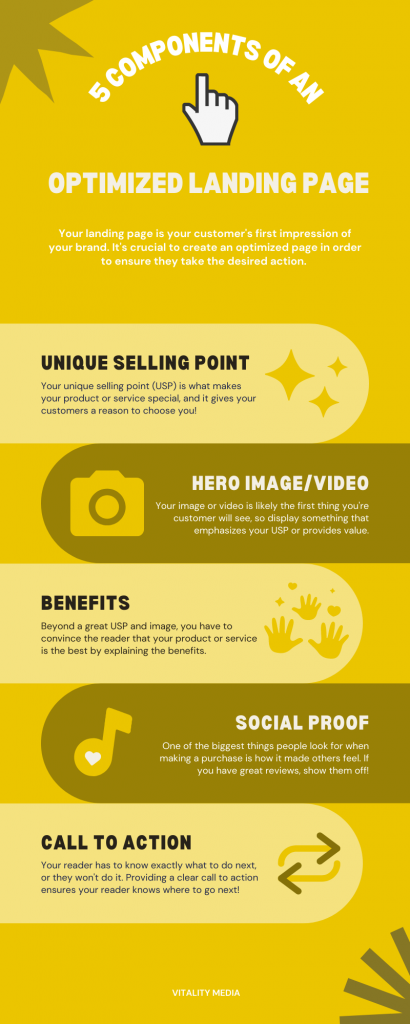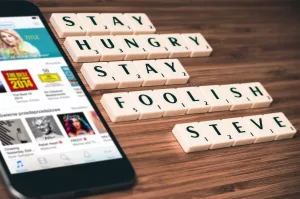Among all great landing pages, a few components have remained the same. You may be thinking, “Each landing page I’ve been on looks completely different,” and you’re absolutely right!
However, each optimized landing page I’ve studied contains these same 5 keys, no matter how different they may look!
Following these keys doesn’t mean copying and pasting a perfect landing page, but implementing them in a way that amplifies your brand voice and drives conversions like never before! In this post, I’ve forged these components into 5 keys to optimize a landing page and increase your conversion rate.
The 5 Keys to Optimize a Landing Page
A landing page is often at the top of the sales funnel, meaning most viewers won’t be familiar with your product or service. This means you must build trust in your brand, while educating viewers on the benefits you provide. To accomplish this, every high-converting landing page implements these five keys:
- Unique selling proposition (USP)
- Visual content
- Features & Benefits
- Social proof
- Call to action (CTA)
1. Unique Selling Proposition (USP)
Your unique selling proposition is essentially the reason your product or service is greater than your competitors, and this is crucial to keep in mind before you begin optimizing landing pages.
Landing pages need to clearly demonstrate this proposition so that your visitors immediately know why to choose your product or service. It’s important to implement this throughout your landing page, without shoving it down your audience’s throat. This can be done through a number of places:
Headline
The headline is the first thing that your visitors read, so it’s crucial to make your USP clear. In your headline, it’s better to lead with your USP and support it throughout the landing page than subtly hint at it throughout the piece.
It’s important to keep this somewhat brief but don’t worry, there are plenty of other spaces to promote your USP.
Subheading
It’s difficult to explain your entire USP in one headline, so with your subheading, you can go a little further into detail. The supporting headline typically provides an overview of the page content, which should generally be centered around your USP.
Conclusion
Throughout your content, you should go into detail on the supporting information of your USP, without mentioning it unless it’s a long-form landing page.
Once your content is concluded, you can summarize it with a closing statement that reflects your USP, ensuring they either take action or leave your website with your brand in mind. You’ll also want to create an engaging CTA, which we’ll go into detail on in #5, to give a clear direction for your viewer.
2. Visual Content
When you enter a landing page, you’ll likely notice the visual content before the written content. This makes it super important to create content that supports your USP. This can be done in a number of ways:
- Live product images
- Explainer videos
- Product diagrams
Live product images, especially with faces, draw attention better than any title will. This is because we’re mentally wired to prefer looking at people, particularly faces. If you have any live images of your product or service in action, this is a great place to show them off!
Explainer videos are incredibly helpful, especially for service and saas companies, because they can give the viewer an understanding of your product, service, or software that couldn’t be attained through pictures or text.
Product diagrams are incredibly effective in displaying the benefits of a product, which we’ll go into further detail below. Diagrams can be a great resource to explain parts of the product or even visually display aspects of the product that can’t be seen.
3. Features & benefits
The copy of your landing page doesn’t need to be long; it just needs to clearly demonstrate the benefits of choosing your product or service. It’s also important to understand the difference between a feature and a benefit.
A feature describes an aspect of your product or service, while a benefit describes the impact of the feature. For example, a feature of the bed is the memory foam mattress, while a benefit is the deeper sleep that you gain from the memory foam:
Separately, both of these can be used to provide insight into your product. However, by combining the two, you can give the viewer the logical and emotional triggers to purchase.
For example, the mattress company may say, “Experience true comfort with our memory foam mattress”. This tells the reader what is so great and why it’s so great in just one sentence!
4. Social Proof
People have a natural tendency to look toward others when making decisions. We want to see how others feel when using the product or service in order to determine how we’ll feel. In order to feed this human instinct, you can use a number of tools including:
- Reviews
- Case studies
- Customer logos
- Portfolios
Reviews can be simply obtained by sending out an email to everyone who has purchased your product or service. If you don’t have any customers, you can offer free or discounted products or services in return for a review.
Case studies are a great way to give your viewer an idea of what kind of results you’re getting. This can include statistics from clients or even independent projects that display your skillset.
Customer logos work great for any B2B company. It lets your viewer know which companies are currently trusting you, which immediately boosts your credibility.
The last form of social proof is a portfolio. If you provide a service such as web design or content creation, portfolios give the reader a window into the quality of your work, which lets them know whether or not they’d like to see it replicated for their company.
5. Call to Action (CTA)
Last but certainly not least, focusing on a single conversion goal is crucial to optimizing landing pages. This means you should only be asking your reader to do one thing. If you have multiple conversion goals, create a website or multiple landing pages.
Once you’ve identified your conversion goal, it’s time to craft a CTA. This is done through either text or button CTA’s. You can use text CTA’s at the end of your conclusion, referencing what button to click or what link to visit. You can use button CTA’s to take your reader to their next location and complete your conversion goal.
Here are some examples of button CTA’s I’ve found successful:
- Learn more
- Order now
- Get started
- Get 50% off
- Start my free trial
Once again, avoid shoving it down your viewer’s throat, but don’t be shy with it! Share your call to action at the end of your article and ensure the text is directing the reader in the direction of your call to action.
I personally recommend A/B testing with CTA’s because slight changes can have a colossal effect on how your reader interacts with your landing page.
Begin to Optimize a Landing Page
Now that you understand the 5 keys of to optimize a landing page, it’s time to get started and create your own! You can get started for free with tools like GrooveFunnels, which allow you to create incredible landing pages and start selling in no time!
These 5 components will eventually become second nature, but until then you can carry the full roadmap right in your camera roll!





